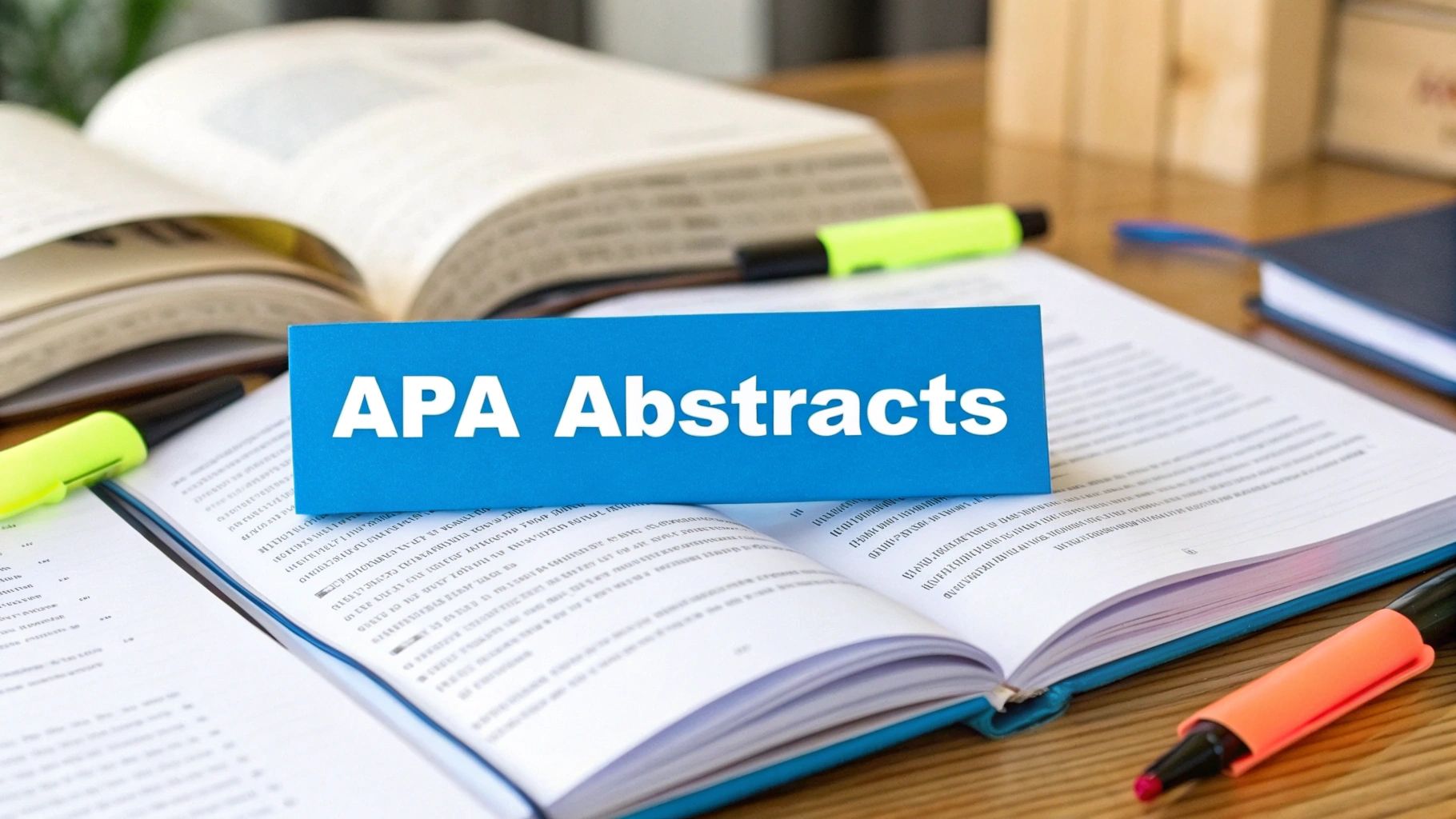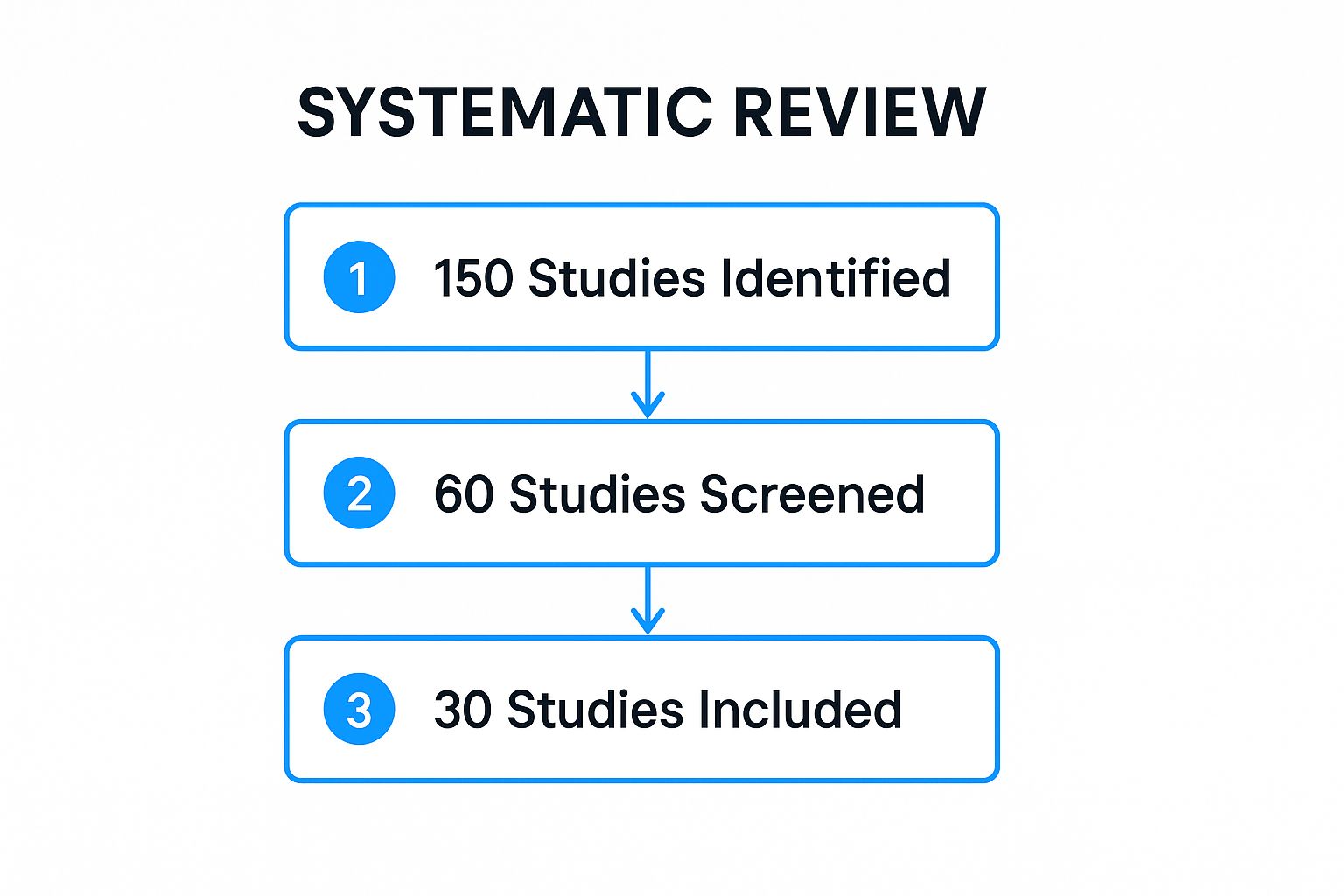7 Perfect Abstract Example APA Formats for 2025

The APA abstract is often the most important paragraph in your entire paper. It's the first thing journal editors, conference organizers, and fellow researchers read, acting as a concise summary and a critical first impression. A well-written abstract can determine if your work gets read, cited, or even published. Mastering this specific format, however, can be challenging. It requires a unique blend of brevity and comprehensive detail, all within strict structural guidelines.
This guide moves beyond generic advice by providing a diverse collection of real-world abstract examples. We will dissect each abstract example apa to reveal its underlying structure and strategic choices. You will learn not just what to include, but how to phrase your research problem, methods, results, and conclusions for maximum impact. By analyzing these models from various academic disciplines, you'll gain actionable insights and replicable tactics to craft a powerful, professional abstract that accurately represents your hard work and grabs your reader's attention from the very first sentence.
1. Empirical Research Study Abstract
The empirical research abstract is the most common type found in academic journals, serving as a concise summary of an original study. It provides a structured overview of the research, including the problem, methods, key findings, and implications. This format is essential for researchers and students who need to quickly grasp a study's core contributions without reading the entire paper.

This type of abstract is fundamental because it adheres strictly to the scientific method's reporting standards. It’s the gold standard in fields like psychology, education, and medicine.
Strategic Analysis
A strong empirical abstract follows a clear, predictable structure: Introduction, Method, Results, and Discussion (IMRaD), although these are not used as explicit headings within the abstract itself. The goal is to present a complete, yet brief, picture of the study. Each sentence serves a specific purpose, from stating the research question to highlighting the main statistical outcomes.
Key Insight: The power of this abstract lies in its replicability and clarity. It allows readers to assess the study's validity and relevance quickly by presenting the essential components in a standardized sequence.
Actionable Takeaways
To craft a compelling abstract example APA for an empirical study, follow these tactical steps:
- Start with the Problem: Open with one or two sentences defining the research gap or objective.
- Detail the Method: Briefly describe participants (N = number), design, materials, and procedure.
- State Key Results: Report the most important findings, including specific statistical values (e.g., p-values, effect sizes).
- Conclude with Implications: End with a sentence on the study’s contribution or practical implications.
When drafting, ensuring every component is present is crucial. Some writers find it helpful to use an AI rewriter to refine sentence structure and maintain conciseness while covering all necessary points.
2. Literature Review Abstract
A literature review abstract summarizes a body of existing research on a specific topic. Unlike an empirical abstract, it does not present original data. Instead, it synthesizes information from numerous studies to identify trends, conflicts, and gaps in the current knowledge base, often proposing directions for future research.
This type of abstract is crucial for systematic reviews and meta-analyses, which are foundational in fields like public health and social sciences for establishing evidence-based practices. It provides a bird's-eye view of a field's landscape.
Strategic Analysis
A successful literature review abstract outlines the scope of the review, the sources consulted, and the main conclusions drawn from the synthesis. The structure typically includes the topic's importance, the review's objectives, the information sources and inclusion criteria, and the principal conclusions or themes that emerged from the analysis. Its purpose is to convey the breadth and key takeaways of the synthesis.
Key Insight: The value of this abstract is in its comprehensive synthesis. It demonstrates the author's expertise by weaving together disparate sources into a coherent narrative that moves the field forward.
Actionable Takeaways
To create an effective abstract example APA for a literature review, apply these strategies:
- Define the Scope: Clearly state the topic and the primary question or objective of the review.
- Describe the Method: Mention the search strategy, databases used (e.g., PsycINFO, PubMed), and the number of studies included.
- Summarize Key Themes: Highlight the main patterns, major debates, or critical gaps identified in the literature.
- State the Conclusion: Conclude with the overall implications of the review and suggest avenues for future research.
3. Theoretical/Conceptual Abstract
A theoretical abstract introduces a new conceptual framework, model, or argument without presenting original empirical data. It summarizes the core theoretical contribution, explains its foundations in existing literature, and outlines the implications for future research and practice. This type of abstract is crucial in fields like philosophy, management theory, and theoretical psychology, where advancing concepts is as important as testing them.
This format is essential for communicating complex ideas succinctly. It allows scholars to grasp the essence of a new theory and its potential impact on their field, making it a key component for non-empirical scholarly articles.
Strategic Analysis
A successful theoretical abstract focuses on building a logical argument. Unlike the IMRaD structure, it follows a more narrative flow: Problem/Gap, Proposed Solution/Theory, and Implications/Contribution. The primary goal is to persuade the reader that the proposed conceptualization offers a novel and valuable perspective on a significant issue. Each sentence works to build this case.
Key Insight: The strength of a theoretical abstract lies in its clarity and intellectual contribution. It must distill a complex argument into its most essential components, making the new theory accessible and highlighting its unique value.
Actionable Takeaways
To compose an effective abstract example APA for a theoretical paper, follow these tactical steps:
- Define the Intellectual Problem: Start with one or two sentences that identify a gap, paradox, or inconsistency in existing theory.
- Introduce the New Concept: Clearly state your proposed theory, model, or framework as the solution or a new way of thinking.
- Explain the Core Logic: Briefly outline the main tenets or components of your theoretical argument.
- State the Contribution: Conclude with the implications of your theory for future research, practice, or understanding.
When writing, focus on making the abstract accessible. For those looking to refine complex ideas into more engaging prose, exploring strategies for humanizing AI content can offer useful techniques for improving clarity and connection with the reader.
4. Case Study Abstract
A case study abstract summarizes an in-depth investigation of a single individual, group, organization, or event. It highlights how a detailed examination of a specific instance can illuminate broader principles, test existing theories, or reveal new insights. This format is crucial in fields where context and nuance are paramount, such as clinical psychology, business, and education.
This type of abstract is valuable because it bridges the gap between theoretical concepts and real-world application. It is commonly seen in publications like the Journal of Abnormal Psychology or the Harvard Business Review, where deep dives into specific cases drive understanding.
Strategic Analysis
A successful case study abstract must quickly establish the uniqueness and relevance of the case. It typically outlines the background of the case, the methods of analysis (e.g., interviews, observation, document review), the key findings derived from the analysis, and the broader implications. The goal is to justify why this one case is worth studying and what it teaches the wider field.
Key Insight: The strength of a case study abstract is its narrative power. It frames a specific story to answer a larger "So what?" question, demonstrating how micro-level details can have macro-level significance.
Actionable Takeaways
To write an effective abstract example APA for a case study, use these steps:
- Introduce the Case: Begin by presenting the subject and explaining the rationale for its selection.
- Describe the Framework: Briefly state the theoretical framework or analytical lens used to examine the case.
- Present Core Findings: Summarize the key insights or patterns that emerged from the in-depth analysis.
- State the Contribution: Conclude by explaining how the case study's findings contribute to, challenge, or refine existing knowledge.
5. Methodological Abstract
A methodological abstract introduces a new research method, technique, or instrument. Instead of focusing on the findings of a study, it centers on the development, validation, and practical application of the methodological innovation itself. This format is crucial in fields like psychometrics and statistics, where the tools of research are as important as the results they produce.
This type of abstract serves to advance a discipline by providing researchers with new, more effective, or more efficient ways to conduct their work. It's common in specialized journals like Psychological Methods or the Journal of Personality Assessment.
Strategic Analysis
The core strategy of a methodological abstract is to persuade readers of a new method’s value and utility. It describes the method, explains its advantages over existing approaches, and presents evidence of its reliability and validity. The focus shifts from "what we found" to "how you can find things better." It justifies the creation of a new tool by clearly outlining its purpose and superior functionality.
Key Insight: A strong methodological abstract example APA acts as both an announcement and a user manual. It must be compelling enough to encourage adoption by demonstrating tangible improvements, such as greater accuracy, reduced time, or broader applicability.
Actionable Takeaways
To write an effective methodological abstract, follow these tactical steps:
- Introduce the Methodological Gap: Begin by describing the problem that existing methods fail to solve adequately.
- Present the New Method: Clearly and concisely describe the new technique or instrument you have developed.
- Provide Validation Evidence: Summarize the key results from your validation studies, including essential statistics (e.g., reliability coefficients, factor loadings).
- State Practical Advantages: Conclude by highlighting the new method’s applications and benefits for other researchers.
Drafting this requires a balance between technical precision and persuasive clarity, a process that can be refined when you explore strategies for creating AI content and then adapting it for a specialized audience.
6. Intervention/Program Evaluation Abstract
An intervention or program evaluation abstract assesses the effectiveness of a specific program, treatment, or intervention. It details the program's components, implementation, and outcomes, blending empirical rigor with a focus on practical application. This abstract is crucial for stakeholders in public health, education, and social work who need to understand a program's real-world impact.
This format is vital for translating research into action. It provides clear, evidence-based insights into whether a program works, for whom it works, and under what conditions, guiding policy and practice.
Strategic Analysis
A successful intervention evaluation abstract highlights both the process and the outcomes. It describes the intervention clearly, explains how its success was measured, and reports on its effectiveness. The narrative must connect the program's activities directly to the observed results, demonstrating a cause-and-effect relationship.
Key Insight: The strength of this abstract example APA is its practical significance. It moves beyond theoretical findings to provide actionable evidence that can inform decisions about funding, implementation, or scaling a program.
Actionable Takeaways
To write a powerful intervention or program evaluation abstract, follow these steps:
- Define the Intervention: Start by clearly stating the program or intervention being evaluated and its objectives.
- Outline the Evaluation Method: Briefly describe the participants, design, and key measures used to assess both implementation fidelity and outcomes.
- Report Core Outcomes: Present the primary results, focusing on the practical and statistical significance of the program's impact.
- State the Conclusion: End with a concise statement on the program's effectiveness and its implications for future practice or policy.
When finalizing the abstract, ensuring originality and clear communication is key, which is a common concern when using AI tools in academic writing. A well-structured abstract effectively communicates the program's value.
7. Systematic Review/Meta-Analysis Abstract
A systematic review or meta-analysis abstract synthesizes findings from all available research on a specific question. It provides a highly structured summary of the review's objectives, data sources, eligibility criteria, and the results of the comprehensive analysis, which often includes a statistical synthesis (meta-analysis) of the combined data. This format is crucial in evidence-based fields like medicine and public policy.
The infographic below illustrates the filtering process common in systematic reviews, showing how a large number of initial studies are narrowed down to a final, relevant set for analysis.
This visualization highlights the rigorous selection protocol, a hallmark of systematic reviews that ensures the resulting synthesis is based only on high-quality, relevant evidence.
Strategic Analysis
The strength of a systematic review or meta-analysis abstract comes from its adherence to strict, transparent reporting guidelines, such as PRISMA (Preferred Reporting Items for Systematic Reviews and Meta-Analyses). The abstract must clearly articulate the entire research synthesis process, from the search strategy to the final conclusions, allowing readers to evaluate the review's comprehensiveness and reliability. It’s a powerful tool for summarizing an entire body of literature.
Key Insight: This type of abstract provides a bird's-eye view of the current state of knowledge on a topic. Its value lies in its methodological rigor and ability to produce a more definitive conclusion than any single study could offer.
Actionable Takeaways
To create an effective abstract example APA for a systematic review or meta-analysis, follow these guidelines:
- State the Objective: Clearly define the research question being addressed by the review.
- Describe Data Sources: Briefly mention the databases searched (e.g., PsycINFO, PubMed) and the search date range.
- Explain Study Selection: Outline the criteria used to include or exclude studies from the review.
- Summarize Data Synthesis: Report the main quantitative results, such as the overall effect size, confidence intervals, and measures of heterogeneity (e.g., I²).
- Conclude with Significance: State the main conclusions and their clinical or theoretical implications.
7 Abstract Types Comparison
| Abstract Type | Implementation Complexity 🔄 | Resource Requirements ⚡ | Expected Outcomes 📊 | Ideal Use Cases 💡 | Key Advantages ⭐ |
|---|---|---|---|---|---|
| Empirical Research Study Abstract | Moderate to High – detailed methodology | Moderate – requires original data | Clear evidence-based conclusions | Experimental or observational studies | Complete research overview, validity check |
| Literature Review Abstract | Moderate – synthesis of multiple sources | Moderate to High – extensive literature | Comprehensive topic summary, identifies gaps | Dissertation chapters, grant proposals | Establishes research context, identifies gaps |
| Theoretical/Conceptual Abstract | Moderate – conceptual development | Low to Moderate – no empirical data | New theoretical models, conceptual clarity | Theoretical research, model development | Advances theory, stimulates debate |
| Case Study Abstract | Moderate – in-depth focus on specific case | Moderate – rich qualitative data | Detailed insights, hypothesis generation | Clinical cases, business, education | Rich detail, practical applications |
| Methodological Abstract | High – introduces new methods, validation | High – technical validation needed | Improved research methods, enhanced quality | Research methods development, psychometrics | Advances methodology, precision improvement |
| Intervention/Program Eval Abstract | Moderate to High – combines empirical & practical | Moderate – data & implementation info | Real-world effectiveness, practice guidance | Program evaluation, clinical & public health | Practical application, policy & practice impact |
| Systematic Review/Meta-Analysis Abstract | High – strict protocols, statistical synthesis | High – extensive data & analysis | Definitive answers, reduces bias | Clinical guidelines, policy development | Highest evidence level, informs decisions |
Bringing It All Together: Your Abstract as a Strategic Tool
Navigating the nuances of academic writing can be daunting, but as we've explored through a diverse range of examples, the APA abstract is far more than a simple summary. It is a powerful, strategic tool designed to communicate the essence of your complex work concisely and effectively. From the data-driven precision of an empirical study abstract to the conceptual synthesis of a literature review, each type serves a unique purpose, yet they all share a common foundation of clarity, structure, and impact.
Key Takeaways for Crafting Your Abstract
The core lesson from every abstract example apa we analyzed is that structure is your greatest asset. Whether you are outlining a methodological innovation or presenting the findings of a meta-analysis, adhering to the fundamental components-introduction, methods, results, and discussion-provides a reliable roadmap for both you and your reader. Remember, the goal is not just to inform but to persuade. A well-crafted abstract convinces your audience that your paper is worth their valuable time.
Actionable Next Steps
To translate these insights into practice, start with a "skeleton draft." Before writing a single full sentence, use bullet points to outline the single most important piece of information for each required section of your abstract. This approach forces you to distill your research to its most critical elements.
- Objective: What is the one-sentence problem or question?
- Methods: What was the core methodology or approach?
- Results: What is the single most significant finding?
- Conclusion: What is the primary implication or takeaway?
Once you have this framework, you can flesh it out into complete sentences, ensuring every word serves a purpose. Continuously refer back to the specific examples in this guide that align with your research type. This practice will help you master the subtle yet crucial differences in tone and focus, transforming your abstract from a requirement into a compelling gateway to your full study. Ultimately, mastering the art of the APA abstract is a vital academic skill, enabling you to participate more effectively in scholarly conversations and amplify the reach of your work.
Struggling to find the perfect phrasing or worried about repetitive language in your draft? Word Spinner is an intelligent rewriting tool designed to help you refine your sentences for clarity and impact. Use Word Spinner to polish your abstract, ensuring your key findings are communicated with precision and professionalism.


